Chapter 4. Carbohydrates
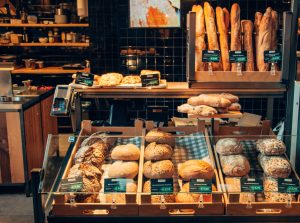
Chapter Outline
- Monosaccharides
- Disaccharides
- Polysaccharides
- The Functions and Benefits of Carbohydrates
Introduction
Most people are familiar with carbohydrates, one type of macromolecule, especially when it comes to what we eat. To lose weight, some individuals adhere to “low-carb” diets. Athletes, in contrast, often “carb-load” before important competitions to ensure that they have enough energy to compete at a high level. Carbohydrates are, in fact, an essential part of our diet; grains, fruits, and vegetables are all natural sources of carbohydrates. Carbohydrates provide energy to the body, particularly through glucose, a simple sugar that is a component of starch and an ingredient in many staple foods. Carbohydrates also have other important functions in humans, animals, and plants.
Carbohydrates can be represented by the chemical formula (CH2O)n, where n is the number of carbons in the molecule. In other words, the ratio of carbon to hydrogen to oxygen is 1:2:1 in carbohydrate molecules. This formula also explains the origin of the term “carbohydrate”: the components are carbon (“carbo”) and the components of water (hence, “hydrate”). Carbohydrates are classified into three subtypes: monosaccharides, disaccharides, and polysaccharides.
4.1 | Monosaccharides
Learning Objectives
By the end of this section, you will be able to:
- Describe the chemical nature of monosaccharides and ways in which individual monosaccharides can differ from one another.
- Name some common monosaccharides.
Monosaccharides (mono- = “one”; sacchar- = “sweet”) are simple sugars, the most common of which is glucose. In monosaccharides, the number of carbons usually ranges from three to seven. Most monosaccharide names end with the suffix “-ose.” If the sugar has an aldehyde group (the functional group with the structure R-CHO), it is known as an aldose, and if it has a ketone group (the functional group with the structure RC(=O)R’), it is known as a ketose. Depending on the number of carbons in the sugar, they also may be known as trioses (three carbons), pentoses (five carbons), and or hexoses (six carbons). See Figure 4.2 for an illustration of some monosaccharides.

The chemical formula for glucose is C6H12O6. In humans, glucose is an important source of energy. During cellular respiration, energy is released from glucose, and that energy is used to help make adenosine triphosphate (ATP). Plants synthesize glucose using carbon dioxide and water, and glucose in turn is used for energy requirements for the plant. Excess glucose is often stored as starch that is catabolized (the breakdown of larger molecules by cells) by humans and other animals that feed on plants.
Galactose (part of lactose, or milk sugar) and fructose (found in sucrose, in fruit) are other common monosaccharides. Although glucose, galactose, and fructose all have the same chemical formula (C6H12O6), they differ structurally and chemically (and are known as isomers) because of the different arrangement of functional groups around the asymmetric carbon; all of these monosaccharides have more than one asymmetric carbon (Figure 4.3).
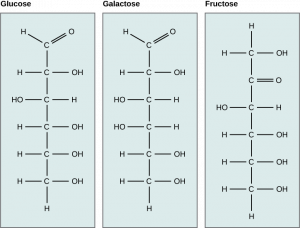
Glucose, galactose, and fructose are isomeric monosaccharides (hexoses), meaning they have the same chemical formula but have slightly different structures. Glucose and galactose are aldoses, and fructose is a ketose.
Monosaccharides can exist as a linear chain or as ring-shaped molecules; in aqueous solutions they are usually found in ring forms (Figure 4.4). Glucose in a ring form can have two different arrangements of the hydroxyl group (OH) around the anomeric carbon (carbon 1 that becomes asymmetric in the process of ring formation). If the hydroxyl group is below carbon number 1 in the sugar, it is said to be in the alpha (α) position, and if it is above the plane, it is said to be in the beta (β) position.

Concept Check
Concept Check What kind of sugars are glucose, galactose, and fructose: aldose or ketose?
4.2 | Disaccharides
Learning Objectives
By the end of this section, you will be able to:
- Describe the chemical nature of disaccharides.
- Name some common disaccharides and their constituent monosaccharides.
- Name the type of bond that holds monosaccharides together & identify it in a disaccharide structure.
Disaccharides (di- = “two”) form when two monosaccharides undergo a dehydration reaction (also known as a condensation reaction or dehydration synthesis). During this process, the hydroxyl group of one monosaccharide combines with the hydrogen of another monosaccharide, releasing a molecule of water and forming a covalent bond. A covalent bond formed between a carbohydrate molecule and another molecule (in this case, between two monosaccharides) is known as a glycosidic bond or glycosidic linkage (Figure 4.5). Glycosidic bonds can be of the alpha or beta types.

Common disaccharides include lactose, maltose, and sucrose (Figure 4.6). Lactose is a disaccharide consisting of the monomers glucose and galactose. It is found naturally in milk. Maltose, or malt sugar, is a disaccharide formed by a dehydration reaction between two glucose molecules. The most common disaccharide is sucrose, or table sugar, which is composed of the monomers glucose and fructose.

4.3 | Polysaccharides
Learning Objectives
By the end of this section, you will be able to:
- Describe the chemical nature of polysaccharides.
- Name some common polysaccharides and their functions.
A long chain of monosaccharides linked by glycosidic bonds is known as a polysaccharide (poly- = “many”). The chain may be branched or unbranched, and it may contain different types of monosaccharides. Starch, glycogen, cellulose, chitin, and peptidoglycans are primary examples of polysaccharides.
Starch is the stored form of sugars in plants and is made up of a mixture of amylose and amylopectin (both polymers of glucose). Plants are able to synthesize glucose, and the excess glucose, beyond the plant’s immediate energy needs, is stored as starch in different plant parts, including roots and seeds. The starch in the seeds provides food for the embryo as it germinates and can also act as a source of food for humans and animals. The starch that is consumed by humans is broken down by enzymes, such as salivary amylases, into smaller molecules, such as maltose and glucose. The cells can then absorb the glucose.
Starch is made up of glucose monomers that are joined by α 1-4 or α 1-6 glycosidic bonds. The numbers 1-4 and 1-6 refer to the carbon number of the two residues that have joined to form the bond. As illustrated in Figure 4.7, amylose is starch formed by unbranched chains of glucose monomers (only α 1-4 linkages), whereas amylopectin is a branched polysaccharide (α 1-6 linkages at the branch points).

Glycogen is the storage form of glucose in humans and other vertebrates and is made up of monomers of glucose. Glycogen is the animal equivalent of starch and is a highly branched molecule usually stored in liver and muscle cells. Whenever blood glucose levels decrease, glycogen is broken down to release glucose in a process known as glycogenolysis.
Cellulose is the most abundant natural biopolymer. The cell wall of plants is mostly made of cellulose; this provides structural support to the cell. Wood and paper are mostly cellulosic in nature. Cellulose is made up of glucose monomers that are linked by β 1-4 glycosidic bonds (Figure 4.8).
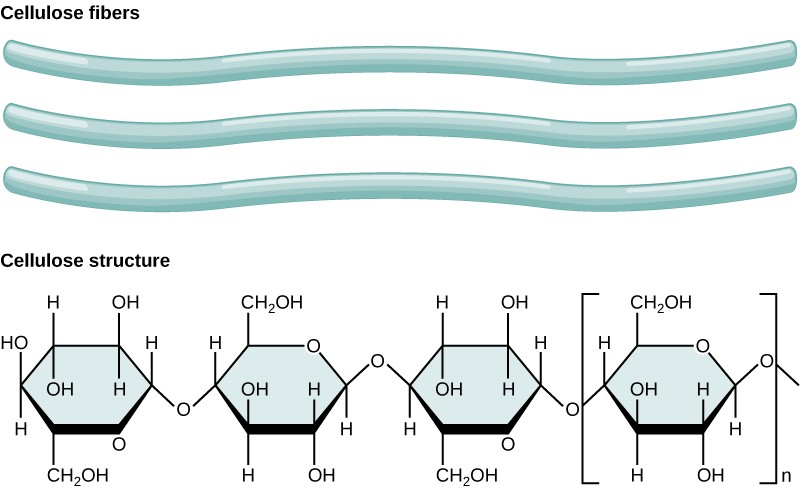
As shown in Figure 4.8, every other glucose monomer in cellulose is flipped over, and the monomers are packed tightly as extended long chains. This gives cellulose its rigidity and high tensile strength—which is so important to plant cells. While the β 1-4 linkage cannot be broken down by human digestive enzymes, herbivores such as cows, koalas, buffalos, and horses are able, with the help of the specialized flora in their stomach, to digest plant material that is rich in cellulose and use it as a food source. In these animals, certain species of bacteria and protists reside in the rumen (part of the digestive system of herbivores) and secrete the enzyme cellulase. The appendix of grazing animals also contains bacteria that digest cellulose, giving it an important role in the digestive systems of ruminants. Cellulases can break down cellulose into glucose monomers that can be used as an energy source by the animal. Termites are also able to break down cellulose because of the presence of other organisms in their bodies that secrete cellulases.
Chitin forms the outer skeleton, called the exoskeleton, of arthropods (insects, crustaceans, and others) (Figure 4.9). Chitin is a nitrogen-containing polysaccharide that is made of repeating units of N-acetyl-β-d-glucosamine, a modified sugar. Chitin is also a major component of fungal cell walls.
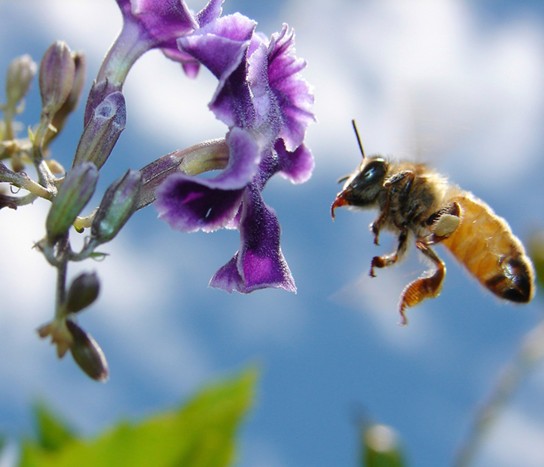
Peptidogylcans are the primary component of the cell walls of bacteria. Like chitin, peptidoglycans have nitrogen- containing sugars linked into long chains. Unlike chitin, peptidogylcans have short chains of amino acids attached to the sugars. These amino acids form peptide bonds between peptidoglycan molecules, linking strands together.
Many antibiotics, such as penicillin and its derivitives, target bacterial peptidoglycans. A common staining protocol, called Gram staining, can distinguish between different types of bacterial cell walls and help health care workers determine which antibiotic should be used. Gram postitive bacteria have thicker cell walls that retain more of the purple Gram stain.
4.4 | Functions and Benefits of Carbohydrates
4.4.1 Carbohydrate functions
As described above, carbohydrates serve a variety of functions in cells. For example, disaccharides, starch, and glycogen serve as energy storage molecules, since they are composed of monosaccharides. Plants, algae, and some bacteria make monosaccharides using energy from the sun, in a process called photosynthesis. Photosynthesis essentially converts energy from the sun into chemical energy in the bonds of glucose. Glucose is broken down by cellular respiration or other pathways to convert its energy into ATP, the primary fuel molecule for cells.
Other carbohydrates, including cellulose, chitin, and peptidoglycans, are structural molecules. They are formed from long chains of monosaccharides that are cross-linked by hydrogen bonds or peptide bonds into tough, fibrous sheets.
Carbohydrates can also be used to build other complex molecules. For example, in the next chapter you will learn that the nucleic acid DNA contains a sugar called deoxyribose. Sugars can also be used to make some of the amino acids that cells use to build proteins.
An important class of carbohydrates is found on the outer surface of many cells. These carbohydrates serve as identity markers to help cells of multicellular organisms recognize and communicate with each other (Figure 4.10).
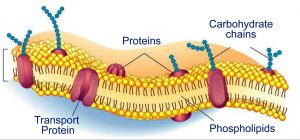
4.4.2 Carbohydrate Benefits
Are carbohydrates good for you? People who wish to lose weight are often told that carbohydrates are bad for them and should be avoided. Some diets completely forbid carbohydrate consumption, claiming that a low-carbohydrate diet helps people to lose weight faster. However, carbohydrates have been an important part of the human diet for thousands of years; artifacts from ancient civilizations show the presence of wheat, rice, and corn in our ancestors’ storage areas.
Carbohydrates should be supplemented with proteins, vitamins, and fats for a well-balanced diet. Carbohydrates contain soluble and insoluble elements. The insoluble part, known as fiber, is mostly cellulose. Fiber has many uses; it promotes regular bowel movement by adding bulk, and it regulates the rate of consumption of blood glucose. Fiber also helps to remove excess cholesterol from the body by binding cholesterol in the small intestine, preventing it from entering the bloodstream, and causing it to exit the body via the feces. Fiber-rich diets also reduce the occurrence of colon cancer. In addition, eating a meal containing whole grains and vegetables gives a feeling of fullness. As an immediate source of energy, glucose is broken down during the process of cellular respiration, which produces ATP, the energy currency of the cell. Without the consumption of carbohydrates, the availability of “instant energy” is reduced. A low-calorie diet that is rich in whole grains, fruits, vegetables, and lean meat, together with plenty of exercise and plenty of water, is the most sensible way to lose weight.
![]()
Registered Dietitian
Obesity is a worldwide health concern, and many diseases such as diabetes and heart disease are becoming more prevalent because of obesity. This is one of the reasons why registered dietitians are increasingly sought after for advice. Registered dietitians help plan nutrition programs for individuals in various settings. They often work with patients in health care facilities, designing nutrition plans to treat and prevent diseases. For example, dietitians may teach a patient with diabetes how to manage blood sugar levels by eating the correct types and amounts of carbohydrates. Dietitians may also work in nursing homes, schools, and private practices.
To become a registered dietitian, one needs to earn at least a bachelor’s degree in dietetics, nutrition, food technology, or a related field. In addition, registered dietitians must complete a supervised internship program and pass a national exam. Those who pursue careers in dietetics take courses in nutrition, chemistry, biochemistry, biology, microbiology, and human physiology. Dietitians must become experts in the chemistry and physiology (biological functions) of food (proteins, carbohydrates, and fats).

